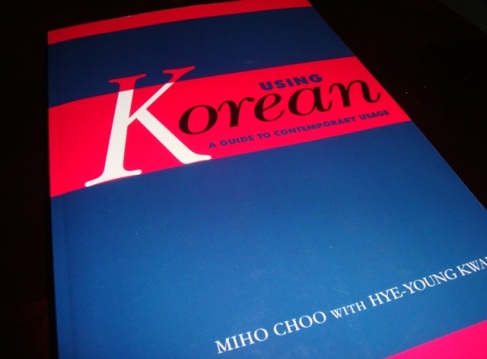I’ve been going through this list of the 6000 Most Common Korean Words for the past few days. It’s really made me wonder how these words were determined to be the “most common” words in the Korean language… At first, the order of the words seems to make sense. Obviously 하다 and 있다 are going to be pretty high up there on the list of common Korean words. But it takes a couple thousand words to get to 어머, and to get to it you have to first go by words like brokerage (증권사) and a military company (부대). And “저고리” (the jacket part of 한복) is more common than “구두” (shoes)?!
Anyway, despite the nonsensical ordering of the words, this is a pretty helpful list. I’ve been adding the ones I’m not familiar with into my flash cards database, along with example sentences from Daum and Naver so I can better understand their usage. I would definitely not recommend that anyone just copy the English definitions that are provided on that website. The same goes for any list of words that you’ll find on the Internet, including other users’ lists on sites like Quizlet. Although I appreciate all the work that was put into matching each word with an English definition for this list, and most of the time they are correct, there are a few reasons why I think it’s better to search for definitions yourself instead of using other people’s work:
1) Looking up words and writing/typing them out yourself will help you remember them because you’ve experienced the act of engaging with that word. One of my Anthropology profs once suggested that we study in different places and in different environments so that we would be able to jog our memory about the subjects we were studying by thinking about the environment. I find this is true for all subjects, including language learning. Oftentimes I won’t remember the meaning of a word right away, but I’ll remember where I was when I looked it up on Daum, or what music I was listening to, or who I was sitting near. Associations like that can jog your memory and you’re more likely to remember what it is you were studying at that time. If you’re just copying/pasting someone else’s list, you won’t have the personal experience with each word and you will be much less likely to remember it.
2) A lot of the time, a simplified definition can really be unhelpful or even misleading. This is why dictionaries can be so frustrating. You get a language-to-language translate of the word without any sense of how it’s used in context. This can really screw you up if you’re relying on a one-word definition from someone else’s flash cards list to understand the meaning of a word.
Imagine this situation. You copy/paste someone else’s vocab list into your own, and start using it in your study rotation. You see the word 저지하다 for the first time, and see the definition the other learner has included for it: “to arrest”. Soon after, you’re talking to your Korean friend about a bank robbery they saw on the news, and you ask “경찰은 그 도둑을 저지했니?” (Did the police ‘arrest’ the thief?). 뭐라고? Your Korean friend gives you a funny look. Turns out that this word doesn’t mean “to arrest [a criminal]” it means “to arrest” as in “to hinder”. Like Arrested Development. Since English has more than one definition for many words, you need to have a better handle of what the Korean word means and not just rely on a simple definition.
The opposite can also be true. Korean words often have more than one meaning. One of the definitions on that list is for 가구, and it says it means “family” in English. True (although its meaning is closer to “household”, but anyway…). But if you just studied that, you’d be pretty alarmed if your friend said to you: “오래된 가구를 버리고 새 가구를 사고 싶어”… “I want to get rid of my old family and buy a new one”?? Actually, 가구 also means “furniture”. So it’s important that you know all the meanings of a word (or at least the most common ones) to avoid confusion.
3) It’s important that you not only study single words, but also sentences, or you won’t know how to use the words. I usually input single words into my study program and also include at least one example sentence as well. I include a different example sentence for each possible meaning of the world. For some verbs, this can mean a lot of example sentences! But it’s well worth it or you’ll get seriously confused if you don’t know that, for example, 타다 means more than just “to ride”. Also, the sentences help because you can choose sentences that are interesting to you or that will be most helpful in the environment you’ll be using Korean in, so you can tailor your studying to your own tastes.
4) Typos! Everyone makes them. It’s inevitable that at some point in a list of words like this, there are going to be typos. If you just copy/paste the words into your study program, you’ll never know. You’ll end up memorizing an incorrect spelling (and pronunciation) of the word. But if you study it on your own, you’ll be putting the word through an online dictionary and will discover that it was misspelled. Crisis averted!
To sum up, while I think using lists such as this one of the “6000 Most Common Korean Words” can be helpful by providing learners with a list of words that they might not have come across before, it won’t be helpful to the learner unless they study it individually and learn each word on their own. If you try to skip the hard work by just copy/pasting someone else’s definitions, you’re much less likely to remember the meaning of the word, and if you do, you could be misunderstanding the meaning entirely!
So keep at it! Even though it seems daunting, if you try to take short cuts in language learning you’re just going to end up having to learn it properly at some point. I have to keep reminding myself this too… 아자!







